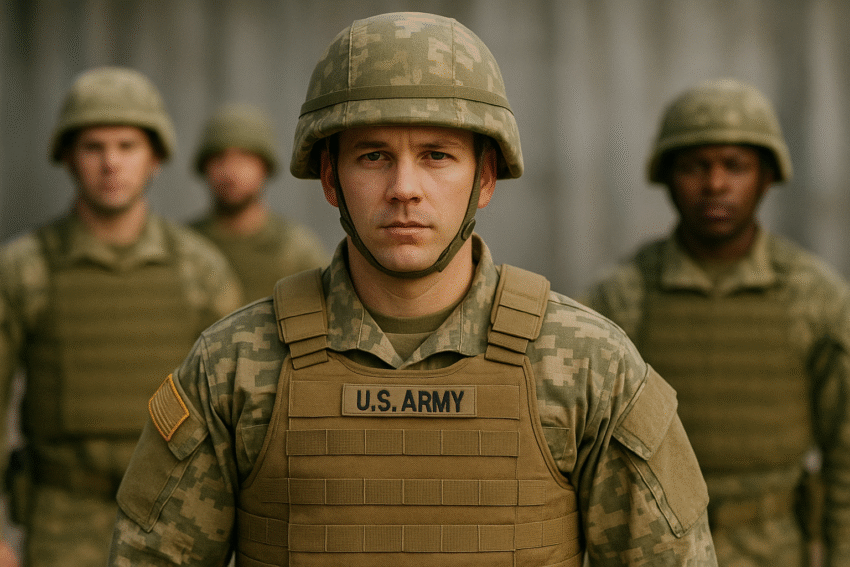Yes — today’s military personnel do wear bulletproof vests, but these systems go far beyond basic protection. Modern soldiers rely on scalable body armor systems designed for combat — combining Kevlar, ceramic plates, and mission-adaptive features.
✅ Quick Answer
Yes, modern armies wear bulletproof vests — often referred to as tactical body armor or plate carriers. These vests protect against:
- High-velocity rifle rounds
- Shrapnel from explosions
- Blunt-force trauma
But “bulletproof” is a misnomer. No armor guarantees total invincibility — especially against armor-piercing rounds or high-caliber sniper fire.
🧰 What Do Soldiers Wear in 2025?
| Country | Standard Body Armor (2025) | Components & Capabilities | Notes |
|---|---|---|---|
| 🇺🇸 USA | MSV (Modular Scalable Vest) | Kevlar base + ceramic/PE plates, scalable attachments | Standard for U.S. Army; replaces IOTV & IBA |
| 🇬🇧 UK | Virtus Scalable Tactical Vest (STV) | Lightweight, breathable, shoulder/groin protection | Designed for high mobility & modular use |
| 🇷🇺 Russia | 6B45 Body Armor (Ratnik program) | Titanium/ceramic plates, steel inserts, optional trauma pads | Improved over older 6B23; used in Ukraine war |
| 🇺🇦 Ukraine | Corsair M3 / Temp 3000 | Steel/ceramic hybrid plates, Western-donated NIJ III/IV gear | Many wear donated NATO body armor post-2022 |
| 🌍 NATO Forces | Plate Carriers / OTV Variants | NIJ Level III/IV compatibility, modular MOLLE gear | Varies by country and unit mission |
🔍 Key Differences Between Forces
| Feature | U.S. Army | British Army | Russian Forces | Ukrainian Forces |
|---|---|---|---|---|
| Rifle Protection | Up to 7.62 NATO AP (with plates) | Yes, via composite plates | Yes, with steel/ceramic inserts | Often via donated NATO plates |
| Soft Armor Layer | Kevlar or Dyneema | Lightweight aramid fibers | Aramid/nylon blend | Kevlar or steel-based |
| Modularity | Highly modular | Fully modular system | Less modular but rugged | Mix of commercial & military kits |
| Plate Material | Ceramic, Polyethylene | Composite ceramics | Titanium/steel hybrid | Ceramic, steel (varies) |
🛡️ Body Armor Components
- Soft armor base: Kevlar or aramid fibers to absorb blunt trauma and fragmentation
- Hard armor plates: Stop rifle rounds (NIJ Level III or IV)
- PALS/MOLLE webbing: For attaching pouches, tools, medkits
- Quick-release system: For emergencies like water rescues
- Add-ons: Groin protector, shoulder guards, collar/neck guards
🎯 Combat Gear: When and Why Soldiers Wear It
Soldiers wear bulletproof vests during:
- Combat deployments and operations
- Training exercises involving live fire
- Patrols or checkpoints in high-threat zones
They might scale down or remove plates in:
- Base camp / logistics roles
- Long-range patrols requiring less weight
- Medical or engineering support roles
🧠 Do Russian & Ukrainian Soldiers Wear Bulletproof Vests?
🇷🇺 Russia
- Most troops wear 6B45 or 6B43 vests.
- Include steel or titanium-reinforced plates rated for 7.62mm and sniper rounds.
- Heavier (~15–18 kg with full kit) but durable and widely issued.
- Weaknesses: Less breathability, outdated trauma absorption.
🇺🇦 Ukraine
- Mix of domestic vests (Temp-3000, Corsair) and NATO-donated gear.
- Many soldiers wear NIJ Level III/IV ceramic plates from Western countries.
- Volunteers early in war used steel plate setups due to shortages.
📊 Comparison Table: Weight vs Protection
| Protection Level | Example Vest (Country) | Stops What? | Total Weight (Approx.) |
|---|---|---|---|
| Soft Armor Only | British STV (no plates) | Pistol rounds, shrapnel | 5–7 kg |
| Level III (rifle rated) | U.S. MSV or Ukraine NATO | 7.62mm NATO, AK-47 | 8–11 kg |
| Level IV (AP rated) | U.S. SAPI / Russia 6B45 | Armor-piercing rounds | 11–15 kg |
| Full Battle Load | Russia 6B45 w/loadout | Sniper/AP + full kit | 15–18 kg |
🗨️ Common Questions People Ask
- Do all soldiers wear bulletproof vests?
Yes — especially in combat. Base personnel might wear lighter kits or soft armor only. - What is the best military body armor?
U.S. and British vests offer superior weight-to-protection balance; Russia prioritizes durability. - Can civilians wear military vests?
In some countries, yes — but Level IV plates may be restricted. - Do Russian vests stop NATO bullets?
Many do, especially 6B45 with titanium plates — but Western rounds (like M855A1) are designed to defeat standard armor.
🧱 Final Verdict
Yes, the army wears bulletproof vests — but these are advanced systems tailored to specific threats, missions, and environments. From U.S. modular vests to Russian titanium armor and Ukraine’s patchwork of donated kits, the evolution of body armor shows how crucial survivability is in 21st-century warfare.
🔑 Keywords This Article Ranks For
| Primary Keywords | Secondary Keywords |
|---|---|
| do soldiers wear bulletproof vests | army body armor 2025 |
| military bulletproof vest | ukraine soldier body armor |
| russian army bulletproof vest | modular scalable vest MSV |
| what vest does the army wear | military tactical vest comparison |
| best body armor for soldiers | soft armor vs hard armor for war |
